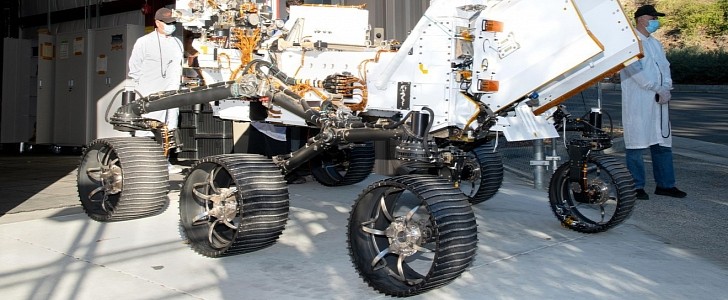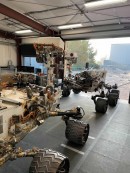NASA's Perseverance rover has been busy drilling into Mars' rocks and collecting samples that could be one day returned to Earth. It's not an easy job to navigate across the rugged surface of the planet in order to get some chunks of an alien world. Luckily, Perseverance has a twin that is here, on Earth, and it's helping the rover avoid potential driving hazards.
OPTIMISM (Operational Perseverance Twin for Integration of Mechanisms and Instruments Sent to Mars) is a replica of Perseverance which serves as a vehicle system testbed, ensuring that rover can safely execute commands on Mars.
Its "playground" is the Mars Yard, a rocky terrain that simulates the surface of the Red Planet. Located at NASA's Jet Propulsion Laboratory in Southern California, the Mars Yard is as long as a tennis court.
Over the years, it has been used as a testing ground, playing a key role in many missions, from the Sojourner that landed on Mars in 1997 to the Perseverance rover that is now exploring the Red Planet. For every mission, a rover twin tested the terrain here on Earth to make sure that everything went smoothly millions of miles away.
OPTIMISM arrived at the Mars Yard last year in September and has since performed several mobility tests. Recently, the twin got some upgrades, including additional mobility software and an adaptive caching assembly responsible for storing rock samples.
In previous tests, OPTIMISM had to drill into various types of rocks and in different terrains. One test involved parking the rover on a slope, then instructing it to drill. The rover successfully completed what it was commanded, showing that its twin can safely do the same on Mars.
But drilling is not enough, as Perseverance also has to store the sample after it collects into sample tubes located inside its belly.
"Now we can do it end-to-end in the test bed," said the Vehicle System Ted Bed systems engineering lead, Jose G. Trujillo-Rojas. "Drill into the rock, collect the core sample, and now we have the mechanism responsible to cache that sample in the cylinder."
Its "playground" is the Mars Yard, a rocky terrain that simulates the surface of the Red Planet. Located at NASA's Jet Propulsion Laboratory in Southern California, the Mars Yard is as long as a tennis court.
Over the years, it has been used as a testing ground, playing a key role in many missions, from the Sojourner that landed on Mars in 1997 to the Perseverance rover that is now exploring the Red Planet. For every mission, a rover twin tested the terrain here on Earth to make sure that everything went smoothly millions of miles away.
OPTIMISM arrived at the Mars Yard last year in September and has since performed several mobility tests. Recently, the twin got some upgrades, including additional mobility software and an adaptive caching assembly responsible for storing rock samples.
In previous tests, OPTIMISM had to drill into various types of rocks and in different terrains. One test involved parking the rover on a slope, then instructing it to drill. The rover successfully completed what it was commanded, showing that its twin can safely do the same on Mars.
But drilling is not enough, as Perseverance also has to store the sample after it collects into sample tubes located inside its belly.
"Now we can do it end-to-end in the test bed," said the Vehicle System Ted Bed systems engineering lead, Jose G. Trujillo-Rojas. "Drill into the rock, collect the core sample, and now we have the mechanism responsible to cache that sample in the cylinder."
#DYK @NASAPersevere has a twin? The nearly identical rover — OPTIMISM — has a crucial job here on Earth. Recently, it kicked off a series of tests to assess the risk of potential driving hazards its sister may face while exploring the Mars surface. https://t.co/V9o7VW8CUF pic.twitter.com/hD8gJT9gSK
— NASA JPL (@NASAJPL) November 17, 2021






